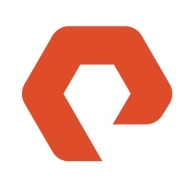


The NetApp FAS Series and IBM FlashSystem compete in enterprise storage solutions. Users have pointed out that while NetApp offers a comprehensive set of features, IBM stands out in performance, particularly for high-speed, low-latency scenarios.
Features: The NetApp FAS Series provides robust data management with features like data deduplication, high availability, and ONTAP for multiprotocol support. It's well-regarded for its integration with large virtual environments, notably VMware. IBM FlashSystem is noted for speed and simplicity, excelling in low latency and IOPS management. It incorporates features such as compression and effective data handling, supporting performance-critical applications efficiently.
Room for Improvement: NetApp FAS Series could benefit from better pricing structures, improved interoperability with evolving cloud technologies, and enhancements in user experience for management and automation. Users of IBM FlashSystem suggest a need for better scalability, enhanced compression capabilities, and cost efficiency, along with improved cloud integration and responsive technical support.
Ease of Deployment and Customer Service: Both NetApp FAS Series and IBM FlashSystem are commonly deployed on premises, offering hybrid cloud options. NetApp FAS is praised for its extensive support resources, although some users report delays from third-party support. IBM is appreciated for its knowledgeable support, although improvements in timeliness and technical adaptability are desired. Customer service for both is viewed positively but can improve in field assistance during complex setups.
Pricing and ROI: NetApp FAS Series is competitively priced with bundled features providing good value for multiprotocol environments. Pricing varies based on specific configurations, with suggestions to improve support costs. IBM FlashSystem, with a potentially higher price point, justifies costs with its performance metrics. Both systems demonstrate positive ROI, contingent on specific deployment requirements and scalability needs.
If you wait more than seven years to buy another one, you get a return on your investment.
The solution can comfortably be stretched from five to seven years without any failures, ensuring a long-lasting return.
We have seen return on investment compared to other OEMs, which took approximately three years after implementing IBM FlashSystem.
If you have the configuration well maintained and configured, you should have good efficiency and compression for the clients and for yourself.
Customers always have their issues resolved promptly.
Technical support is good at least through vendors, not directly with the principal.
Customers of alternatives like Dell and Hitachi enjoy more reliable and comprehensive support services directly from vendors rather than third-party subsidiaries.
I rate the technical support from IBM as a ten.
IBM customer support is responsible, efficient, and responsive, though it is expensive.
Sometimes, the support was inadequate because the initial architecture was poorly defined.
We are also using it ourselves for the SAN and CIFS protocol.
They often provide basic solutions, such as suggesting a failover or a power cycle, which are not the sophisticated solutions we expect from a vendor.
It is highly scalable.
It hasn't broken down anytime in the last six to seven years, despite hurricanes, earthquakes, and power outages.
For larger enterprises, scalability is an issue as the price becomes prohibitive.
The problem arises when migrating data to a later IBM FlashSystem version due to issues with firmware compatibility.
The scalability of IBM FlashSystem is exceptional, and I rate it as a nine.
We normally avoid current versions and use versions that have been running for at least two months in client usage before updating drivers.
NetApp FAS Series is scalable, and it is possible, but you need to pay.
The NetApp FAS Series is scalable and offers numerous solutions, but only if customers are willing to invest in the shelves.
I would rate the stability of the product at seven out of ten.
Customers have infrastructure that is 100% stable.
The firmware and software engine have fewer bugs, which enhances operational efficiency.
When panic occurs on the node, it reboots itself, and we have experienced numerous hardware-related issues.
Most things are tailor-made, and we avoid downtimes even with primitive CLI commands.
We would appreciate a built-in transparent failover in the next release to eliminate the need for a separate metro cluster.
One way to improve the product is to add an operational assistant that doesn't depend on VMware.
I would like to see some AI features that would allow arrays to intelligently identify threats or unusual behavior in the data pattern and give an alert.
Despite marketing promises, these features do not function effectively and can impact performance.
There is room for improvement in the troubleshooting part, specifically related to IBM Spectrum for Insight.
An additional function that could be helpful is reducing the time it takes to delete volumes, especially if they are compressed or deduplicated.
Storage companies should create encrypted storage solutions between the OS and storage to protect against ransomware attacks.
Nutanix leads the business in this approach, and I feel that NetApp is missing some aspects, such as CPU, GPU, and RAM, in its AI portfolio.
There is an opportunity there for NetApp with Cloud Volumes ONTAP.
While the prices may be higher than those of other vendors, we see it as a market leader with benefits.
The support can be a bit pricey, but the solution is more cost-effective than anything else out there.
I would rate the solution as an eight out of ten in terms of costliness.
To install or upgrade any software features, the cost is high, which makes it challenging for smaller companies who do not require advanced features like deduplication or compression typically needed by larger organizations.
The pricing is high; storage solutions are always expensive.
The pricing of NetApp FAS Series is not cheap, but in comparison to other vendors, NetApp FAS Series is affordable.
Its data compression feature is the best that we have ever seen.
The standout features for us in Pure FlashArray X NVMe are its robust DDoS protection, seamless transparent failover, and failback capabilities ensuring high availability.
Pure FlashArray X NVMe helps to improve our processing speed.
There is a significant amount of data reduction, achieving a ratio of one to three.
The most valuable features are performance and reliability.
There is built-in compression, a data reduction feature, and artificial intelligence-driven insights that calculate warnings and errors to redirect to customers automatically.
While NVMe disks are expensive and require three disks for parity calculations, hard drives in NetApp FAS Series are inexpensive, making it more cost-efficient per GB, even with RAID tech implementation.
Our IOPS are very high, reaching somewhere about 50k to 150k or 1.150k.
One important feature for customers is its ease of use and continuity, enabling seamless usage across on-premise and cloud environments.



| Company Size | Count |
|---|---|
| Small Business | 15 |
| Midsize Enterprise | 11 |
| Large Enterprise | 12 |
| Company Size | Count |
|---|---|
| Small Business | 47 |
| Midsize Enterprise | 21 |
| Large Enterprise | 59 |
| Company Size | Count |
|---|---|
| Small Business | 31 |
| Midsize Enterprise | 37 |
| Large Enterprise | 57 |
Pure Storage FlashArray//X is the world’s first enterprise-class, all-NVMe flash storage array. It represents a new class of storage – shared accelerated storage, which is a term coined by Gartner – that delivers major breakthroughs in performance, simplicity, and consolidation.
IBM FlashSystem products are enterprise computer data storage systems that store data on flash memory chips. Unlike storage systems that use standard solid-state drives, IBM FlashSystem products incorporate custom hardware based on technology from the 2012 acquisition of Texas Memory Systems. This hardware provides performance, reliability, and efficiency benefits versus competitive offerings.
NetApp FAS series is an enterprise-level storage system that provides a wide variety of data management services, including data protection, block and file storage, and data management.
NetApp FAS is designed to be highly scalable, allowing your organization to grow storage capacity on demand. NetApp FAS also supports multiple protocols, including NFS, SMB, iSCSI, and Fibre Channel, as well as various storage architectures, including SAN (Storage Area Network) and NAS (Network-Attached Storage).
The FAS series has multiple data protection and data management features, including snapshots, cloning, replication, and deduplication, to help secure your data and manage it more efficiently. The system integrates with other NetApp products and solutions, to create a unified data management platform. The system can be deployed on-premise, on multi-cloud environments, or hybrid.
NetApp FAS Series Benefits and Features
NetApp FAS series provides its users with several key benefits and features, including:
Reviews from Real Users
NetApp FAS Series stands out among its competitors for a number of reasons. Several major ones are its speed, reliability, and a wide variety of features.
Adriano S., IT project and infrastructure service manager, writes, “The replication feature is noteworthy because it's faster than most and it uses little bandwidth. Then there's the friendly interface that the equipment offers. With this interface, it is very easy to manage.”
Temitope O., a NetApp product manager at Hiperdist Ltd, says, “I like the unified management feature because sometimes you end up running a single protocol on the entire system. You rather have a system for a particular protocol and another system for other protocols, especially in a big environment like mine.”
We monitor all NAS reviews to prevent fraudulent reviews and keep review quality high. We do not post reviews by company employees or direct competitors. We validate each review for authenticity via cross-reference with LinkedIn, and personal follow-up with the reviewer when necessary.